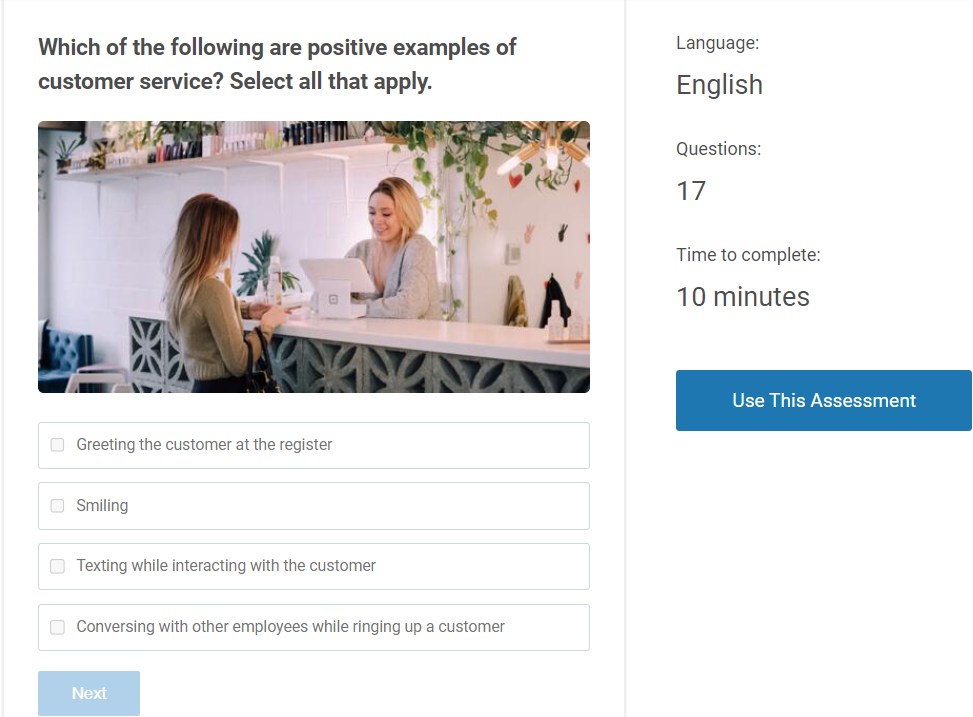Competency-based training (CBT) is the most potent form of employee training. You’ll find out how as you proceed through this post.
The success of online employee training programs depends on thoughtful planning, the type of modules you use, and how you use them. It’s also about giving well-defined routes and directions to learning based on learners’ needs.
If you’ve been using a generic training approach, we understand that it can sometimes become difficult to judge what, how, and when participants are learning.
CBT can help you overcome it by tailoring your training according to specific learning goals or outcomes and based on the skill requirements of your employees.
This type of training is not new, but recently it has gained popularity due to its effectiveness and business advantages.
After you’re done reading reading this post, you’ll know what competency-based training is, why many organizations focus on it, its advantages and limitations, and how to implement it company-wide.
What Is Competency-Based Training?
Competency-based training is a type of employee training that focuses on specific skills or competencies. In this learning system, learners must demonstrate the required knowledge and skills (competency) on a topic or task before advancing to the next level.
Here, training is broken down into small units, each focusing on a single key skill.
| If you think you can do it, that’s confidence. If you do it, that’s competence. – Morris Code |
For example, you can train your learners using modules in an online course. Each module focuses on a specific competency. Learners need to master it and meet course objectives first before moving to the next related and usually more advanced topic.
Fast learners and those with prior experience will gain competency quicker than newbies and slow learners.
After completing a course, learners receive certificates or other forms of recognition for their qualifications.
This type of training is also known as outcome-based training or skills-based training. It’s tied to a certain outcome or skill acquisition that learners are expected to make at the end of a course. They must demonstrate an ability to perform a task following such training programs.
Watch: What Is Employee Training?
6 Competency-Based Training Examples
Here are some examples of competency-based training programs that you can implement in your company. They focus on specific and in-demand skills in the modern workplace.
1. Workplace Communication Training for Employees
Communication skills training serve as the foundation for healthy relationships in the workplace. This training can help you sharpen your communication skills and improve your interactions with others. It discusses different types of workplace communication, including non-verbal. Employees at all levels can undergo this program.

2. Analytical Skills Training
Analytical skills trainings are a must, especially for those in leadership positions. They should be able to make sense of data and make sound decisions that are strategically significant for their businesses. Data collection, organization, analysis, and decision-making are the topics in this course.

3. Skills to Resolve Workplace Conflict
Modern workplaces are diverse, and people of different personality types work there. In such a situation, conflicts are bound to arise. So, managing and resolving conflict situations is an in-demand skill among employees. This training program discusses methods, such as active listening and communication to resolve workplace conflicts and turn them into engines for productivity, growth, and progress.
Watch: What Is Workplace Conflict Resolution Training? | Course Introduction
4. Making a Sales Pitch
Sales presentations are one of the litmus tests for sales professionals’ competency. This online course on making a sales pitch presents the art and science of making compelling sales pitches that audiences find hard to resist. It’s designed to help salesforces pick this key skill and excel at their job.
Watch: Making a Sales Pitch
5. Handling Sales Objections
This skill is another must-have for salespersons. It’s about identifying opportunities in a seemingly negative situation involving a sales barrier or concern. Employees with this skill are capable of building lasting relationships with prospects and establishing themselves as worthy business partners. This course discusses common objections in sales and some proven techniques to overcome them.
Watch: Handling Sales Objections
6. Managing Customer Expectations
Customer support teams in any business or industry are responsible for addressing customers’ concerns and meeting or exceeding their expectations. This is one of the key skills expected of such a team. This course takes you through how to understand and manage customer expectations, provide positive experiences to them, and keep them satisfied and delighted.

Want to Explore More Topics for Employee Skills Training?
Differences Between Competency-Based Training & Traditional Training
| Traditional Training | Competency-Based Training |
|---|---|
| Generic and vague learning objectives | Targeted at specific skills and learning objectives |
| Provides streams of information without opportunities for skill practices | Performance-based rather than mere knowledge acquisition |
| Everything is planned by instructors with little to no input from learners | Learners are partners in L&D initiatives, and they take full responsibility for their learning |
| Rule-bound, rigid, and guided solely by grades - high achievers and low achievers | Flexible and focuses on addressing each learner’s unique needs through personalized learning |
| Uses summative assessments | Uses formative assessments |
| Learners are upgraded to the next level regardless of what and how well they learn | Learners are upgraded only after demonstrating mastery of a skill or competency |
Easily Deliver Competency-Based Training Using a Robut Cloud LMS
Why Many Organizations Adopt Competency-Based Training
Ever wondered why learning & development (L&D) departments and training managers love competency-based training?
Well, there are several valid reasons.
Some of the main ones are:
Competency Gaps Analysis
Competency-based training and assessments provide organizations with a reliable way to identify skills or competency gaps in their employees. This is important as a lack of necessary skills often obstructs employees from performing at their maximum capacity. Gaps also negatively impact productivity, performance, and business goal achievement.
Effective Employee Development Plans
Once organizations complete a competency assessment, they have all the insights they need to develop an impactful employee L&D plan. They feel more confident about charting their employees’ career paths and associated development plans. This enables employees to achieve career advancements through promotions and succession planning.
Better HR Decision-Making
Competency-based training and gap analyses help HR executives too. With data on skill gaps, they are better positioned to make informed decisions about recruitment, onboarding, training, and performance management. Therefore, it enables organizations to make strategic decisions on human capital.
These are the top benefits of using competency training at the organizational level. In the next section, we look at some general benefits of this training type.
Get Free Employee Training Software — All Features, Forever.
We've helped 567 companies train 200,000+ employees. Create courses in under a minute with our AI LMS or use 200+ ready-made courses on compliance, harassment, DEI, onboarding, and more!
Advantages of Competency-Based Training
No human being will work hard at anything unless they believe that they are working for competence. – William Glasser
Some of the advantages or benefits of a competency-based training model are as follows:
- Identification of skill gaps so you can provide targeted training
- Personalized development plans for employees based on their learning needs
- Cost-efficiency as it focuses on specific skills and participants unlike large-scale training programs
- Availability of relevant training materials since CBT is designed around a specific skill or competency
- Less overwhelming for learners as they don’t have to learn multiples things at a time
- Better knowledge retention as learners remain focused on a specific skill area
- A better way to identify employees for promotion & succession plans
- An effective way to map career paths
- Lower turnover due to continuous employee training & development
Limitations of Competency-Based Training
Despite all the advantages it brings to the table, CBT has its share of limitations or weaknesses. They are worth knowing before you implement this training type in your organization.
- It focuses on an organization’s immediate needs without considering the uncertain future situations.
- It doesn’t suit skill areas such as leadership & management, where knowledge and competencies keep evolving rapidly.
- The training itself won’t cut it without follow-up assistance for employees.
- The training will remain ineffective if the process of identifying existing competencies in employees is poor.
- When you rely on a single material for CBT and do not utilize a combination of courses, guides, knowledge base, checklists, mentoring, and coaching, it wouldn’t be truly competency-based.
- CBT may not fit into the learning styles and preferences of some learners.
- Since there’s no fixed timeframe for mastering competency, it may lead to procrastination among learners.
- It neglects social learning since participants will be learning their individuals’ skills in their own way.
How to Implement Competency-Based Training
Now we have come to the most important part of this discussion – how to deploy competency training in an organization. Like other corporate L&D programs, CBT requires some logical and essential steps to make it successful. Find them out below:
Conduct a Competency Gap Analysis
Make a list of your strategic business goals, current competencies in your employees, and the competencies required in them to achieve the goals. This is the stage where you diagnose competency gaps in your manpower, business processes, and structures.
For example, you can check the current performance requirements in different jobs and whether your employees meet them. Determine what they already know and how they apply that knowledge to their work so that you can decide what additional skills they need to learn.

Choose the Right Online Courses
We have already looked at some examples of online courses you can deploy for competency training. So, you must have a fair idea of the type of course you need for such training.

Here are a few things to keep in mind while choosing the courses:
- Ideally, such courses should be designed by subject-matter experts.
- They should contain up-to-date information.
- Also, they should be easily customizable with content you already have, such as videos, presentations, PDF files, recorded webinars, and podcasts.
- The courses should also have settings for privacy, security, designs, and brand controls.
- Make sure they include engaging elements such as videos, handouts, real-life scenarios, and assessments.
Choose the Best Training Tool
After you identify the right courses for your CBT, you’ll need a tool to deliver them to your audience. This is where a learning management system or LMS comes in.
Generally, these solutions are cloud-based and enable users to create, design, share, and track online courses and tests with local and remote learners. The best thing about them is that they facilitate anytime, anywhere learning. This means learners can take courses and assessments in a self-paced mode using a device of their choice.
Most LMS come bundled with a suite of other related tools for quizzes, collaboration, surveys, knowledge base, and flash cards.
Check out a range of such tools here.
Make sure the LMS you choose comes integrated with these tools. Also, it should support the following:
- A library of ready-to-use courses & templates to get started quickly
- The ability to upload existing content such as videos, PDFs, PPTs, SCORM/Tin Can files, etc.
- Virtual classroom software to centrally manage activities in a secure place
- Multilingual support to easily train a worldwide audience in their preferred language
- Desktop and mobile support for a seamless learning experience across devices
- Multiple instructors and admins for ease of training administration
- Real-time reports and analytics for insights into progress, completion, engagement, and gaps
Watch: How to Choose the Best SaaS LMS Software
Implement the Training Program
After you have the training courses and tools in place, it’s time to implement the program.
Whether you’re talking about one learner or a large group, sharing the courses should be effortless. For example, ProProfs Training Maker provides several easy options to share a course with learners.
You can share a link to a course or a classroom via email, embed it on your website, or share it on social media.

Your learners can take the course from anywhere and anytime using their devices.
Once your learners start taking the course, you’ll get a notification about it.
You can keep a course public or private based on your needs and audience type.
Evaluate Results
Once your learners complete the training, it’s time to evaluate the outcomes.
Let’s take the example of ProProfs for better understanding.
With this LMS, you can analyze completed and pending courses, who took a course and when, total time taken, results of in-course quizzes, and certification status.
You can also view learner reports and group reports. Statistics show the consolidated data visualizations of all course activities.
Similarly, online survey reports show feedback on chapters, courses, and instructors. From this, you can know the course performance and the competency of your instructors.
Based on these training results, you can either proceed with your learners to other training or ask them for a retake.
Watch: How to Analyze Training Course & Quiz Results
Conduct Follow-Up Assessments
Even though you’ve concluded a competency training program, it’s still not the end. A few more activities remain.
This is the time for employees to reflect on what they’ve learned and what action plans they will come up with to achieve new professional goals.
You can put those employees who have performed well in training under monitoring and further assessments. Observe how well they apply their learning to their jobs. Ideally, there should be some measurable improvement in their competency following the training.
Along with on-the-job observations, you can use other post-training job performance evaluation methods such as:
- self-assessment questionnaires to judge their own knowledge & skill levels
- 360° feedback from managers and peers for honest observations on employees who work with them
- customer feedback surveys to know what they think about you
- focus groups to solicit opinions and suggestions on the quality of training
- key performance indicators (KPIs) such as pass/fail rate and average test score
Watch: Using 360° Feedback to Become a Better Leader
Competency Training Case Study
Global Linking Solutions (GLS) is a provider of managed computer network and security services located in North Carolina. It designs, stages, configures, and deploys commercial-grade data networks and security assets worldwide.
The issues: GLS has employees in six different states working 24/7. They faced the issue of a lack of effective communication and cohesive training. One of the questions was: How does it train its managers when they’re spread across different states in different time zones?
The company also had a turnover rate of about 30%.
Based on both internal and external evaluations, the chief complaint was a lack of cohesive training.
Solution: GLSI explored 15 different LMS and ultimately chose a competency training software where it found the pre‑built management training courses phenomenal. The company put together a management training program basically using all the pre‑built courses.
GLS also used the pre-employment quizzes to assess customer serviceability and critical thinking ability.
The pre-built courses brought the knowledge, skills, and expertise that GLS didn’t have in‑house.
Result: Training became much more efficient and flexible, and it immensely helped the company deliver specialized technical skills to its employees. The company could deliver onboarding and training at any given time for different groups. Managers could pull out training reports at any time. Things that it did one‑on‑one became completely automated.
Get Free Employee Training Software — All Features, Forever.
We've helped 567 companies train 200,000+ employees. Create courses in under a minute with our AI LMS or use 200+ ready-made courses on compliance, harassment, DEI, onboarding, and more!
Upskill Your Employees Through Competency-Based Training
The competency-based training model is the most effective form of employee training. It focuses on a specific skill and individual and supports need-based personalized learning. This way, it accelerates knowledge acquisition and professional growth, unlike the traditional methods that offer generic information.
Competencies such as communication skills, analytical skills, and sales skills are always in demand in all companies across industries. Only targeted training programs like competency training can educate employees on these core competencies and set them up for success.
To recap what we discussed, implement competency training through the following measures:
- Conducting skill gaps analysis to identify what competencies you should target
- Choosing the right courses that are expert-designed, editable, and self-paced
- Choosing the best tool for training creation, management, delivery & tracking
- Additionally, ensure to optimize your delivery routes to enhance logistical efficiency and streamline operations
- Training implementation and providing seamless learning experiences anytime, anywhere
- Evaluation of training results to gauge completion rate, performance, test scores, and challenges
- Follow-up assessments through workplace observations, self-assessments, and customer feedback
If you look at this, these steps for competency training are similar to those you follow for other training types. The only difference is with CBT, training becomes more fine-tuned.
Start deploying competency-based training across your organization and easily achieve employee development and business goals. Remember, the more competent your employees become, the more competitive you get!
 Tips
Tips
We’d love to hear your tips & suggestions on this article!
Get Free Employee Training Software — All Features, Forever.
We've helped 567 companies train 200,000+ employees. Create courses in under a minute with our AI LMS or use 200+ ready-made courses on compliance, harassment, DEI, onboarding, and more!

 We'd love your feedback!
We'd love your feedback! Thanks for your feedback!
Thanks for your feedback!







